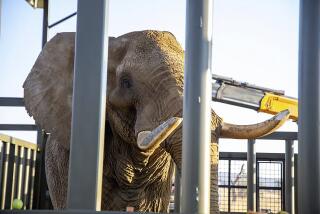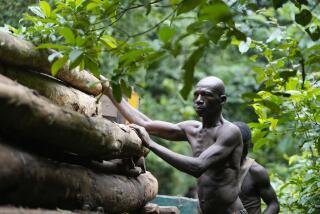Ivory Coast, Although $10 Billion in Debt, Is Opening New Game Park
ABOKOUAMEKRO, Ivory Coast — Twelve miles from President Felix Houphouet-Boigny’s hometown, where artisans are finishing a basilica as grand as St. Peter’s in Rome, a new game park will soon open.
Environmentalists are against it on grounds that the Ivory Coast, which hasn’t made payments on its $10-billion foreign debt for more than a year, can’t afford to maintain its existing parks, let alone open a new one.
Government officials say the total budget for all national parks is equivalent to about $450,000, and Comoe National Park, home of the Ivory Coast’s largest elephant population, will receive no money this year.
Representatives of the French designer of the new, $20-million Abokouamekro park say they have no quarrel with conservationists who deplore the collapse of the Ivorian park system.
“Sometimes it is better to start with something new and new people,” said Benoit Desbans of the French Cultural Activities for Nature Conservation (ACCN). He said Comoe National Park, in a remote northwestern part of the nation, was simply too big--4,072 square miles, larger than Yellowstone National Park--to be effectively managed by the Ivorian government.
The official government newspaper Fraternite Matin, in a series of articles deploring the state of Comoe, said the government has the will but not the money to pay for maintenance of the park. Falling prices for Ivory Coast’s exports, primarily agricultural commodities like cocoa, have left the government unable to pay bills. It is $1 billion behind in payments on its foreign debt.
Goal of Self-Support
ACCN hopes to make the new park pay for itself by drawing at least 100,000 visitors a year and selling meats from game when herds are thinned.
The new park is on a former ranch in rolling hills southwest of Yamoussoukro, the president’s hometown. A small river was dammed to form an 865-acre lake. A tourist hotel will be built on an island in the lake.
The park will ultimately cover 232 square miles, about the area of Chicago, but will be opened in stages. The first section, 148,200 acres, is scheduled to open in September. The Roman Catholic basilica, which the government says will cost $133 million and is being paid for from the president’s private funds, also is expected to be completed by September.
2 Rhinos Donated
The park has already been stocked with more than 400 antelopes, 46 hartebeests and 46 forest buffalo captured at Comoe by a South African team. Six South African savannah elephants were purchased and shipped to the park, and South Africa has donated two white rhinos.
Many other types of animals, including giraffes, hippopotamuses, lions and zebras will be added to the park, some from South Africa. The South African government has been quick to help the government of Houphouet-Boigny, an opponent of economic sanctions being imposed on South Africa.
The Ivory Coast has no organized environmental lobby, but officials of several government departments have privately criticized the park as little more than an expensive zoo.
“The park certainly is feasible but that doesn’t mean desirable,” said Anthony Hall-Martin, a South African who is one of Africa’s leading authorities on elephants. “One would rather see the indigenous animals protected. Perhaps there is a middle path.”
Deficient Security
Rod Henwood, the South African game warden who led the team that captured animals for Abokouamekro, said security there was deficient.
“Poaching began on the second day after the animals arrived,” he said, but Henwood and other members of the South African party said it could be the equal of almost any African park with the proper management.
Comoe’s animal population has been decimated by poachers over the years. An article in Fraternite Matin described Comoe as “an immense abandoned territory, left to itself for the grand pleasure of poachers, and the distress of the hundreds of species of animals who survive there.”
Another article said that in 1978, the park had 1,500 elephants, but, “today it is a luxury to come across one.”
Only 3,000--or 300
At one time, the Ivory Coast had about 100,000 elephants. The government estimated more than a year ago that they now number fewer than 3,000, although it had not made a definitive count.
After a recent visit to Comoe, Hall-Martin said he feared the park’s elephant population could be as low as 200. He emphasized, however, that his research was not broad enough to be definitive.
Government sources said Hall-Martin’s estimate could be right. They added that at the present rate of poaching for the animals’ tusks, by 1995 none will be left in the Ivory Coast, a nation named for the ivory trade that flourished along the Atlantic shore here beginning in the 16th century.
On a recent 90-minute, low-level flight over the park, not a single elephant was seen. The bloated carcasses of 11 hippos were sighted floating in the Comoe River.
Chemicals May Be Cause
Pilot Michele Cotte, an advocate of the cause of elephants and other wildlife, speculated that chemicals used in a recent campaign against the insect that causes river blindness were responsible.
Cotte has been one of the leaders of a campaign to save a small group of forest elephants in the mangrove swamps of Asagny Park on the coast 55 miles west of Abidjan, the capital.
Cotte, a French citizen who has lived in the Ivory Coast for 21 years, has been flying over the park for nine years, keeping careful notes on the movements of the elephants. During her first count, in 1980, she sighted 90 elephants. By 1987, the population was down to 46.
About 50 forest elephants, members of a subspecies slightly smaller than the savannah elephants of Comoe, live outside the park, to the west.
More to Read
Sign up for Essential California
The most important California stories and recommendations in your inbox every morning.
You may occasionally receive promotional content from the Los Angeles Times.










